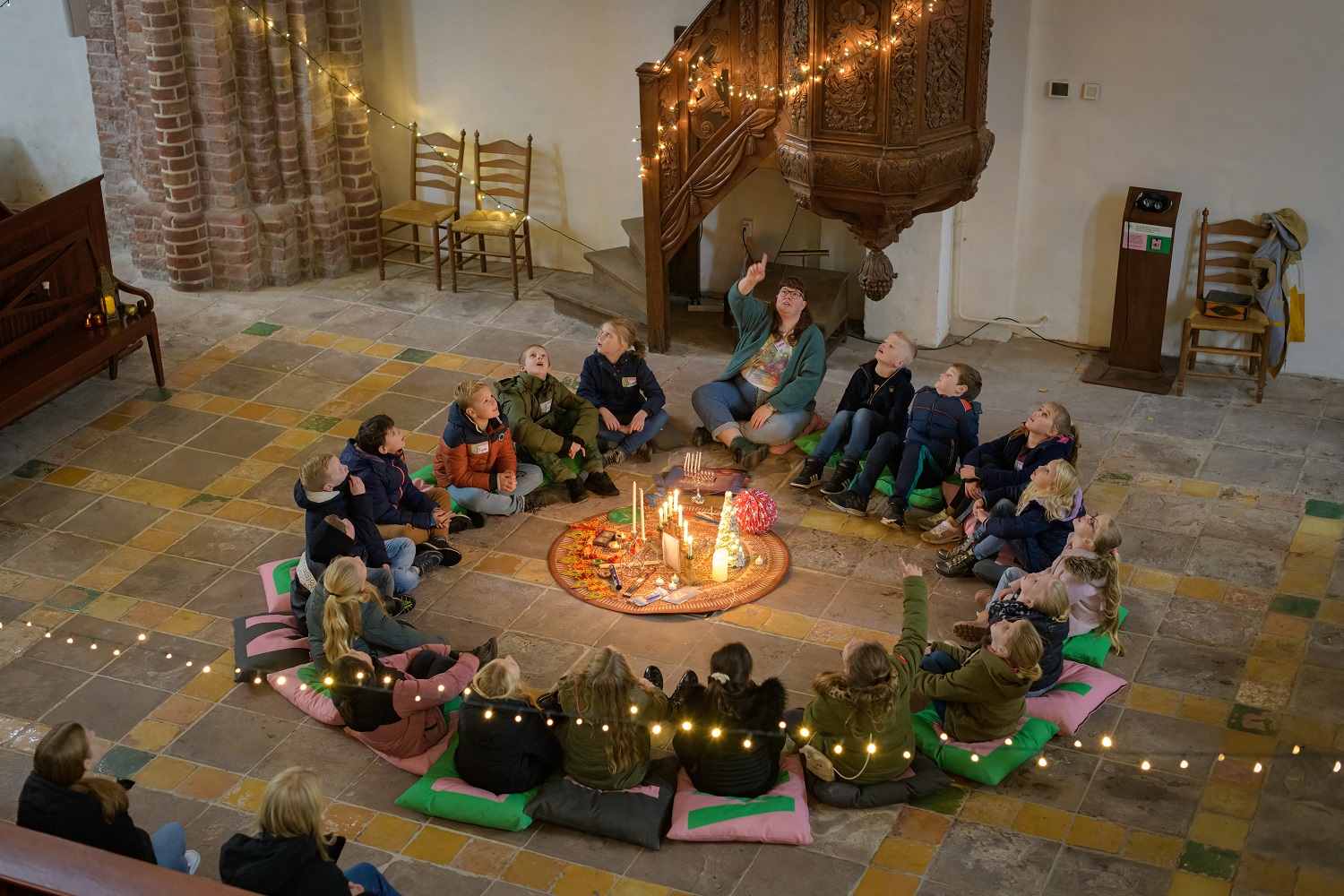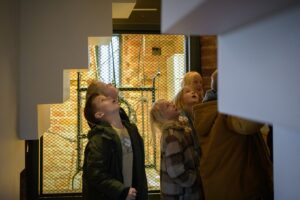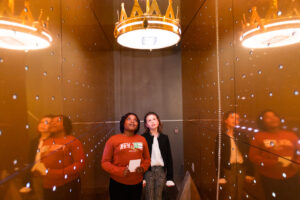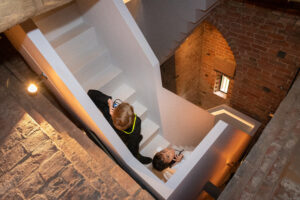
A group of students in the School Church. © Groningen Kerken.
The transformation of the 13th-century church of Garmerwolde into a space for education, culture and dialogue was the recipe for success in giving new life to the ancient church. The School Church opened its doors just as the coronavirus pandemic paralysed the entire world. A challenging beginning that was no obstacle for the project to grow thanks to the support of schools, volunteers and the local community and the determination of Groningen Kerken.
We have recently talked with Inge Basteleur about the results of their efforts and the future plans for this project, which was a finalists of the Religious Heritage Innovator of the Year.
1. How did this project start?
It started in 2014 when the Museum Catharijneconvent from Utrecht reached out to us. They have a collection of Christian art, which includes lots of paintings, statues and religious artefacts. They had an exhibition for children, which was called “Feasts: know what you celebrate” (Feest! Weet wat je viert). They asked us if we wanted to join because they wanted to have this exhibition about religious holidays in every corner of the Netherlands. So we became a partner in the north. That’s actually where the idea, the overarching idea for the School Church came from.
We chose the Church of Garmerwolde because we work with volunteers at our foundation. In every church we work with, we have a group of volunteers who organise activities such as concerts and these kinds of things. In this church, we had a nice committee of volunteers, they were very open to a lot of things. Plus, it’s close to the city of Garmerwolde, and that means that there would be some children who could come by bike. Another important thing is that in this church there are vault paintings from the 16th century, and they depict, on one hand, Christmas, and on the other hand, the story of Easter. So it’s kind of a comic about these two religious holidays. And this was our starting point for the project.
2. How did you adapt this idea to the Garmerwolde church?
The way it looks now is not something that we could have imagined when we started. It has been a really collaborative process from the beginning. The task was to make an exhibition about religious holidays, and that was quite a broad task. Of course, when you’re in a museum, you can just pick some of the pieces that you have in your collection and show them, tell a story around them. But our collection in this church was actually the vault paintings, we couldn’t take them out or whatever to be exhibited.
Then we came up with an idea. The tower which stands next to the church wasn’t really used for anything. So we made a vertical exhibition wing inside of it. We decided to depict holidays from Christian and Islamic traditions. This idea came from the fact that in the Netherlands, the two biggest religions are now Christianity and Islam. Even though more than half of the people in the Netherlands say they don’t really have a religion. So it’s a very secular country, actually. But of course, we have all these churches, so it’s important that people still know something about them, because otherwise, why would you save them? Why would you keep them up?
3. So the initial idea came about in 2014 with this exhibition on Christian and Islamic holidays and then, by 2020, it became something huge…
Yes, of course, we made some plans. We made a bid book. We tested these plans with experts, for example, somebody who translated the Quran, people from the Christian community, and also some students who were studying to become a teacher. They were also Muslim themselves, so they already had the idea of how to translate certain things into children’s language to tell the stories of this religion. And after the bid book, we had to do extensive fundraising. We had a lot of funds to support us. After getting these funds, we could start the restoration of the church to host the exhibition and the new activities we had planned. This began in 2019 and it became something new, something fresh. It was really great.

Students visiting the exhibition “Feest! In Oost en West (Feast! In West and East), “at the School Church © Groningen Kerken.
4. And since then you are running this educational program there. How do you do to find the schools? Do you approach them directly and offer this program or do you promote it in other ways?
Well, in the Netherlands schools are obliged to tell something about different religions in the world, about the diversity of religions. So it’s actually in the educational curriculum, but many teachers find it hard to tell things about this subject, most of the time because they don’t really know anything about. We noticed this quite early on. Some teachers were really eager to come to us because we kind of filled in a void.
I think this situation has changed a bit in recent years, now there’s more attention to this in schools. But when we started, it was really something that the teachers needed. So then even before we started building the exhibition at the church, we did some pilots around certain holidays.
For example, we did a program about Easter and a program about Ramadan, and also one about Besa, the Jewish holiday. We learned a lot from these pilot programmes. And we also made a loto f connections with schools.
In the Netherlands there’s an institution that supports schools to form their educational programs. We got in contact with this institution to say, well, we have this programme and it’s really filling in a void. So we tried to find institutions that had contacts with schools, this process was a bit more top to bottom. But also tried to talk with the teachers, see their needs and adapt our programme to them. In the end, we made partnerships with some.
And this is how we started receiving the first groups of students in the church. One thing that’s really important in that is that we offer transport by bus for them. That is included in the price that we ask them to pay, of course. That helps because otherwise we would have had only schools from nearby and now we have schools that are coming from 50 km away. So it’s very nice that we can have all these children.
5. How many children per month do you receive approximately at the School Church?
In 2022 we welcomed around 1200 children in the School Church. There was a lockdown at the start of the year, and some difficulties for schools, who had to focus on other things to catch up. 2023 will hopefully be our first full year.
If we are fully booked, then we could have 30 children in the morning and 30 in the afternoon. But it’s not really occurring. We opened at the very beginning of the coronavirus pandemic, so we can say we have had a few “false” starts.
The province of Groningen has around 200 schools. Some of them come the first year, and then they want to try a different programme the next year. Today there was a school who had never heard of us before and they came for the first time, but they now want to make it a yearly thing. So that’s really great. So we’re still a bit at the start of this.

Exhibition at the tower of Garmerwolde Church. © Lilian van Rooig
6. But if an adult or a family wants to visit the church and the exhibition they are also welcomed, right? Because you have created a cultural space…
Yes, we have. We have also built a new reception building to make the area of the church more like a museum. In a museum you have many facilities like toilets, a place to put your stuff and a place to sit and stay warm. In this reception building you can have a coffee, which is prepared by the volunteers of the church. You can also buy an audio tour to visit the exhibition at the tower. It’s always open on the weekend.
It was really a great thing that we built this building because now the church is not only used as the School Church, but also as a cultural space that is alive now, with volunteers organising activities regularly. In a few weeks for example there will be a concert.
7. I imagine you have been collaborating with many different professionals to bring this project to reality. About the volunteers, how do they support your work and how do you instruct them to collaborate with you?
Well, that’s actually something that we do for our whole foundation. In Groninger Kerken we manage some 100 churches, so we also have like around 700 or 600 volunteers and a coordinator who recruits and works with them.
In Garmerwolde there was already a group of volunteers, mostly women who did things for the church, some of them for more than 20 years. They were really connected to this church but they were now kind of retired. Now there is a new group of people who do the same things. We have also now a collaboration with the owners of the café building. And the people in Garmerwolde, some of them at least, are really proud that we made this in their town and that children are coming to visit it.
When we won the European Heritage Award we got kind of a lot of media attention and that’s like PR for their village as well. They are also happy that the church is used again and there are things happening. Because when a church it’s closed and nothing happens, it’s kind of like a black hole. So they really appreciate our project.
8. What would you say was the most challenging part in developing project, from the moment you though about the idea to the moment it became a reality?
Well, of course, in the beginning it was very hard because it was a very broad assignment. But it was also a great time because we had a creative team with an architect and designers and me as an educator and somebody from our building engineer group.
We all had our own ideas about this place and what we wanted to do, but we had to merge them in some way. So we had lots of talks and everybody would do research into their own expertise and we could bring that together and then discuss how we wanted to make it. It was really intense time, but it really turned out well, something that we couldn’t have thought of if it had been only two of us, for example. So really we saw the value of that.
Also challenging was of course getting the money because I think if I tell the story to other people they always say, “wow, you do something with Islam in a Christian church, how can you do this?” And that was also something that we found exciting and challenging about the project. Maybe something would happen or maybe not.
But actually, all the people who were involved and the people in the town understood the value of teaching children these things that are seemingly the opposite but actually have lots of things in common. There are really nice stories that we can learn from it and that we can speak and dilaogue about. So we learned that even if something seems a bit out of the box, if you try keep the conversation open you can find the way to make it work.

Students in the tower of Garmerwolde church © Groningen Kerken.
9. So it was challenging but also very positive in the end. I guess also a great level of uncertainty at the beginning, because you started at the beginning of the Coronavirus Pandemic.
Yeah, everything that we had built up to for all these years had a slow start. We opened on the 28 February and then on the 13 March everything was closed. So yeah, we had all these schools that wanted to come and we had to all cancel everything. It was a bit demotivating.
In the summer of 2020, we actually had a group of visitors that we really didn’t anticipate, just grown-ups who were hiking and they wanted to have a look in the tower. So we already started with different audiences.
10. What are your next goals?
We would like to get in, for example, teachers, groups of teachers who can come, but also maybe something for researchers. We’re also receiving some questions from people who want to become teachers. And we’re also working with a synagogue here in Groningen to connect our holidays program with their holidays program. So lots of things actually.
11. Is there any organisation or professional that has approached to you asking to kind of replicate the same model that you have or with an interest in doing a similar project?
Yeah, we do get a lot of positive reactions and people who are exploring and asking the same questions as you did, like “how did you get here”, “where did the money come from” and “how on earth did you manage to do this?” But of course, the idea of school church is very easy to replicate.
I think if you have a church or another building that is empty or isn’t used for anything, then you can always use it for educational purposes, especially if you talk about heritage because there are so many stories connected to these buildings. And you can really make a place alive again if you give the children the feeling that they have their own say in these places, that they can do what they want and maybe do something very playful today.





Follow us: